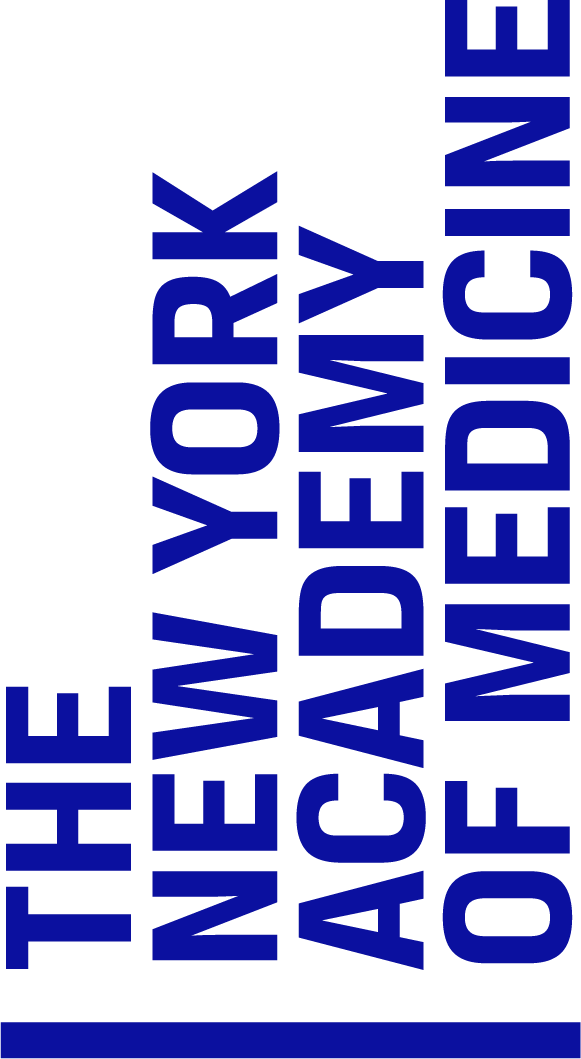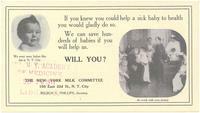Fundraising and Publicity
Warning message
You must
authorize Drupal to use your Google Analytics account before you can view reports.
Primary tabs
Pages
-
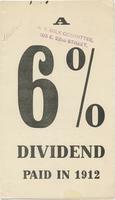
-
A 6% Dividend Paid in 1912
-
A single sheet folded leaflet stating that "8,643 children under 5 years of age" were saved in 1912 thanks to a 6 percent reduction in the infant mortality rate from 1911. This "6% dividend" was paid as a result of the increased availablity of clean milk provided by the New York Milk Committee. The inside provides a bar graph displaying the continously falling infant mortality rate from 1901 to 1905, and asks the reader to consider what the record for 1913 will be if this trend can be continued.
-

-
An Accomplishment (1911) and an Expectation (1912)
-
This single folded sheet leaflet provides a summary of the New York Milk Committee's 1911 accomplishments and a prescription for future action in 1912. Among the triumphs touted are a reduction in infant mortality, the completion of a study of national milk standards, and the apportionment of a grant for the creation of 55 new Municipal Milk Stations. On the back, a reproduced still image from "Care of the Baby," a motion picture filmed for the New York Milk Committee by Thomas A. Edison, depicts mothers, infants, and nurses at a milk station.
-

-
Accomplishments: January-July, 1912
-
A four page brochure of New York Milk Committee progress reports detailing accomplishments achieved in the first six months of 1912. The brochure's cover is adorned with a photo montage of healthy infants, while the back extol's the Committee's work during its first year of activity.
-

-
Are Clean Milk Producers Benefited?
-
"Milk is no longer 'Just Milk," states this leaflet. Reproducing an excerpt form "The Milk Reporter," the case is made that the highest quality of milk will recieve the highest level of montary gain, benefiting clean milk producers. Grades for milk (A, B, C) and the equivalent price set for each, are also included.
-

-
The Baby and the Budget
-
Headlines from the New York Evening Post, the New York Tribune, and the NY Times are reproduced on this 1911 postcard created by the New York Milk Committee. They read: "The Baby and the Budget," "Why More Doctors, Nurses, and Inspectors Are Needed," and "The 'Cops' Spread the News." That "News" is the promotion of the work of milk stations in preventing infant deaths and advocacy for the full budgetary allocation by the NYC Department of Health towards the summer time reduction of infant mortality. A portrait of a healthy baby and a list of "Babies' Rights,"almost all of which deal with milk, are found on the postcard verso.
-

-
Dirt in Loose Milk Shops
-
This postcard produced by the New York Milk Committe's Committee for the Reduction of Infant Mortality reprints a July 26, 1911 NY Evening Post article entitled, "Dirt in Loose-Milk Shops." The article recounts the findings of the Committee's investigations, in coordination with the New York City Department of Health, into the bacterial contamination of milk sold in bulk. On the postcard verso a photo of sickly baby fed on contaminated milk is contrasted with the photo of a healthy baby under the question,"Is It Worth the Difference?"
-

-
Does Fact-Recording Help Your Baby-Saving?
-
This blank postcard promotes the achievements of the New York Milk Committee in its fight against infant mortality up to and including the week of July 29th, 1911. All statistics provided are for children under two years of age. The postcard verso includes a chart of "baby deaths for one year" -- tracking seasonal changes in mortality rates -- and asks the reader to consider, "When does the spurt come in your city?" Contact information for the New York Milk Committee is also provided.
-

-
The House with the Blue Front: Babies' Pure Milk Stations
-
A four-sided circular containing the reprinted text of the article, "The House With the Blue Front," published by the New York Times on Sunday, May 14, 1911. The article highlights and justifies the educational outreach program instituted by the New York Milk Committee as a facet of their fight against infant mortality. This program includes maternal education programs conducted both at milk stations and in the home by visiting nurses. Photographs illustrating these "consultation classes" accompany the text.
-

-
How Many Babies Did Die? (2)
-
A double-sided postcard commending the efforts of Montclair, New Jersey to reduce the number of infants succumbing to diarrheal disease during the hot spell of July 1911. What the mortality rate could have been in other cities, had they followed Montclair's example, is explored. On the back, parents are urged to dress their children for comfort, not looks, during hot summer months.
-
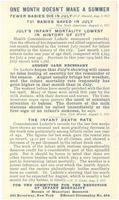
-
One Month Doesn't Make a Summer
-
This postcard states that "731 babies [were] saved in July," and reproduces excerpts from the August 2, 1911 editions of the New York Globe, the New York Herald, the New York American, and the New York World to remind readers that the reduction in infant mortality must be continued in August. On the back, an illustration of a healthy baby accompanies quotations advising readers about "what can be done" to help babies and reminding them that "while there's care there's hope."
-
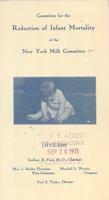
-
Out of Town
-
Within this folded circular produced by the New York Milk Committee is a sentimental poem contrasting the summer holidays of wealthy city dwellers with the fate of working-class infants struck down by disease. Opposing phtographs of healthy children, poor children, country life, and city life emphasize the poem's theme. The back side of the circular lists milk stations where city parents can find care and relief for their children.
Pages











